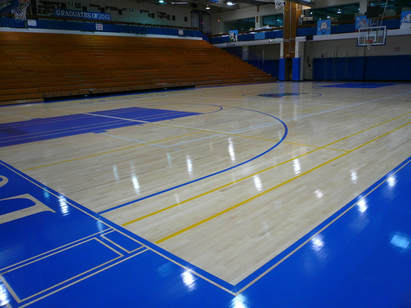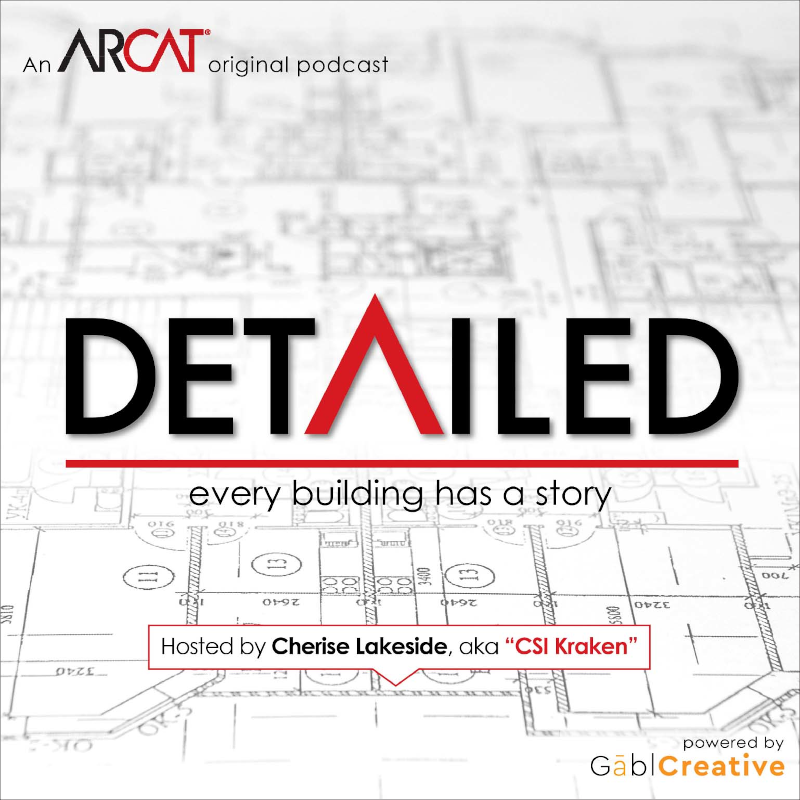|
Contributed by Eric D. Lussier The space is enclosed, the HVAC is running and the basketball backboards are in place. The final touch to your athletic facility is the only item outstanding: the sports floor. You have made your selection and the contractor is scheduled. All you need to worry about is the completed installation, right? Well, have you put thought into periodic maintenance? You always want your facility to look clean and new, but some floors take more work than others. The following provides insights into the various finish options and upkeep factors that must be considered when it comes to choosing from among the many athletic surface options. CONCRETE It seems ridiculous to start the overview with what could seem like no flooring at all, but due to its lifespan and durability, concrete remains a choice in the athletic flooring market. If you are building a new facility, chances are concrete serves as your base substrate regardless of what floor surface is specified. And, whether it is intended for team or individual sports, or for multipurpose use, chances are those activities can occur on a concrete surface. The downside of a concrete surface, however, is the safety factor. While a player may not think twice about shooting hoops on an outdoor concrete basketball court, that same person would likely be apprehensive about lacing up their high tops on an indoor concrete court. Why? Because concrete doesn’t offer any sporting characteristics, such as force reduction, also known as shock absorption. ASTM F2569, Standard Test Method for Evaluating the Force Reduction Properties of Surfaces for Athletic Usability, defines force reduction as the “ability of a surface to reduce impact forces as compared to a rigid surface using a specified impact.” Concrete on its own offers no force reduction. ASTM F2569 was repackaged in the official sports flooring standard: ASTM F2772, Standard Specification for Athletic Performance Properties of Indoor Sports Floor Systems. In 2009, additional criteria were added for surface finish effect, which is the slip and grip of a floor, known as coefficient of friction. Nevertheless, if team or court games will be played on a concrete surface, one important finish application is game lines. Pay attention to the coating used to mark lines on any athletic flooring, as heavy foot traffic and cleaning equipment can take a toll on the paint used. Typically, a polyurethane-based coating with a hardening catalyst is specified for longevity reasons. The concrete surface may also receive a stain or a polish before usage. With these kinds of finishes, high-traffic areas will require upkeep much sooner than low-traffic areas, but one can expect to refinish the surface anywhere from five to 20 years, depending on usage. VCT / LVT (Vinyl Composite Tile / Luxury Vinyl Tile)
With advancements in vinyl tiles in recent years, including those that mimic the appearance of wood, the popularity of luxury vinyl tile (LVT) is on the rise. However, because it offers virtually no shock absorption, the use of any type of vinyl tile in a sport application should be evaluated closely before specification. Traditional vinyl composite tile (VCT) can offer a low initial installation cost up front, but the lifecycle costs are very high on the back end due to the annual maintenance required. VCT requires a wax coating to create a wear layer for protection against scratches and dirt. Normal foot traffic does wear off the wax layer, which needs to be reapplied by stripping off the existing wax, applying a new coating and then polishing. The wax reapplication can be applied as frequently as quarterly or semiannually, but is typically only performed annually in schools. With the factory urethane prefinished options of LVT, including varying thicknesses of anywhere from 8 mil to up to 40 mil, initial installation costs are much greater, but overall it has a lower lifecycle cost than VCT, as it does not require the same upkeep. While some maintenance teams may find LVT easier to clean with fresh wax applied, the factory-applied finish lasts years with only typical cleaning. The thicker the mil finish, the longer the prefinished option will last for LVT. It is important to note that applying a finish to any type of floor affects the coefficient of friction — which can be a very important consideration depending on the needs of the sport to be played on the surface. While a field finish does make a floor easier to maintain, it can become tacky and/or slippery, depending on the type of finish used or amount of finish on the floor, whether freshly applied or remaining after a full year of use. WOOD Still the popular choice for basketball court floors, hardwood (namely maple) is utilized in the market more than 50 percent of the time in gymnasiums. Having been used and proven in the field for well over 100 years, maple flooring has a long track record in the sports surfaces industry. According to the Maple Flooring Manufacturers Association (MFMA), traditional maple gym flooring is only offered by six member mills. Founded in 1897, the MFMA is the authoritative source of technical information about hard maple flooring that “publishes grade standards, guide specifications, floor care recommendations and specifications for athletic flooring sealers and finishes.” While there is a range of different maple systems on the market, athletic applications of traditional maple flooring uses a 2¼-inch-wide by 25/32-inch-thick wood plank with a subfloor system underneath the maple to provide shock absorption. With foam, rubber pads, wood sleepers, plywood or any combination thereof beneath, most wood systems range anywhere from 2 inches to more than 3 inches thick. While the cost of a wood floor can be viewed as affordable up front, the overall lifecycle cost of wood is higher due to annual and periodic maintenance. At the time of installation, the maple is drum sanded, sealed and finished with an oil- or water-based finish. This finish is normally reapplied annually. In addition, every eight to 12 years, the floor will be fully sanded and then resealed, repainted and refinished. These are added costs that can range from $0.25 per square foot annually to $2.00 or more per square foot for a full refinish. This should be taken into consideration when evaluating the overall costs of a wood floor. There are also engineered wood options on the market. Engineered hardwood flooring typically consists of a plywood base layer topped with finished hardwood, with some offering a factory prefinish. Considered more dimensionally stable and less susceptible to expansion and contraction, engineered wood systems come in varying system thicknesses, with most being substantially thinner than traditional maple. While wood floors can handle multipurpose usage, it is not uncommon to see signage indicating “No food or drink allowed” or a floor covered with some sort of tarp or vinyl surface. These protective measures help deflect possible water intrusion while also assisting in prolonging the lifespan of the applied finishes. Wood floors will continue to be the customary choice for athletic use in gymnasiums. If you are comfortable with the annual maintenance costs, have a core focus on athletics and desire that squeak of the sneakers, maple is a great solution for you. You can read part two of this article here.
28 Comments
As the owner of a concrete business myself, it might seem ironic that I would never recommend concrete as the base for an indoor facility. I would advise most to strongly consider wood floors as this article suggests, but I'm not even sure concrete should be mentioned let alone to open the article. I'm sure some may disagree but that's just my personal experience.
Reply
2/26/2019 05:26:59 am
Great! The list is impressive!! There are so many things to read now!!!
Reply
Penny Robinson
4/12/2019 09:18:06 am
I do agree with you, Eric. Concrete flooring is more durable and last long as compared to other alternatives of flooring. However, assistance from experienced professionals could be very useful in such matters. A lot of factors should be taken into consideration while selecting the types of flooring. Besides, a basketball court needs regular maintenance to last long. Ant cracks developed in the floors of a basketball court needs to be repaired immediately to get a better result. To fix such issues with the flooring, contact
Reply
6/4/2021 06:16:05 am
Superb blog and I found it pretty informative! I agreed with your thoughts wood flooring is most popular choice for indoor sports flooring, most of gym owner utilized this as well.
Reply
4/15/2023 04:59:21 am
Choosing the right flooring finish for an indoor sports facility is crucial not only for its appearance but also for player safety and maintenance. While concrete may seem like an unorthodox option, it remains a popular choice due to its durability. However, it lacks shock absorption and requires a finish for sports performance. Vinyl composite tile (VCT) may offer a low installation cost but has high maintenance requirements, while luxury vinyl tile (LVT) has a higher initial cost but lower lifecycle cost. It's important to evaluate the specific needs of the facility before making a decision.
Reply
3/19/2024 01:12:54 am
Your great work has resulted in tangible, beneficial results to us. You’re a force to be reckoned.
Reply
3/19/2024 05:28:51 am
I am amazed by your ability to make complex topics accessible. Thank you for making learning enjoyable.
Reply
3/19/2024 06:29:17 am
I admire your dedication to provide accurate and well-researched information/. Than you for your hard work!
Reply
3/19/2024 07:06:17 am
The articles is well-written and is always insightful which makes them joyful to read.
Reply
3/19/2024 07:37:56 am
You blog is very informative. I love how you tackle complex topics with such clarity and insight.
Reply
3/19/2024 08:29:51 am
This is fascinating information! You show an impressive grasp on this topic.
Reply
5/11/2024 06:40:03 am
I’ve studied your work a lot, and I’m trying to get better at writing myself! Your writing always makes me want to become a writer, too.
Reply
Leave a Reply. |
AboutLet's Fix Construction is an avenue to offer creative solutions, separate myths from facts and erase misconceptions about the architecture, engineering and construction (AEC) industry. Check out Cherise's latest podcast
Get blog post notifications hereArchives
March 2022
Categories
All
|


 RSS Feed
RSS Feed
